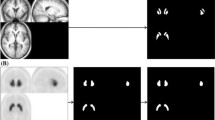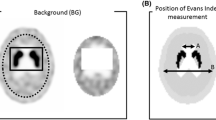Abstract
Objective
Brain dopamine transporter imaging with I-123-labeled radioligands is technically demanding due to the small size of the imaging target relative to the spatial resolution of most SPECT systems. In addition, I-123 has high-energy peaks which can penetrate or scatter in the collimator and be detected in the imaging energy window. The aim of this study was to implement Monte Carlo (MC)-based full collimator–detector response (CDR) compensation algorithm for I-123 into a third-party commercial SPECT reconstruction software package and to evaluate its effect on the quantitative accuracy of dopaminergic-image analysis compared to a method where only the geometric component of the CDR is compensated.
Methods
In this work, we utilized a full Monte Carlo collimator–detector model and incorporated it into an iterative SPECT reconstruction algorithm. The full Monte Carlo model reconstruction was compared to standard reconstruction using an anthropomorphic striatal phantom filled with different I-123 striatal/cortex uptake ratios and with clinical I-123 Ioflupane DaTScan studies.
Results
Reconstruction with the full model yielded higher (13–25%) striatal uptake ratios than the conventional reconstruction, but the uptake ratios were still much lower than the true ratios due to partial volume effect. Visually, images reconstructed with the full Monte Carlo model had better contrast and resolution than the conventional images, with both phantom and patient studies.
Conclusions
Reconstruction with full Monte Carlo collimator–detector model yields higher quantitative accuracy than conventional reconstruction. Additional work to reduce the partial volume effect related errors would improve the accuracy further.





Similar content being viewed by others
References
Eerola J, Tienari PJ, Kaakkola S, Nikkinen P, Launes J. How useful is [123I]beta-CIT SPECT in clinical practice? J Neurol Neurosurg Psychiatry. 2005;76:1211–6.
Kish SJ, Shannak K, Hornykiewicz O. Uneven pattern of dopamine loss in the striatum of patients with idiopathic Parkinson’s disease: pathophysiologic and clinical implications. N Engl J Med. 1988;318:876–80.
Jaber M, Jones S, Giros B, Caron MG. The dopamine transporter: a crucial component regulating dopamine transmission. Mov Disord. 1997;12:629–33.
Djang DSW, Janssen MJR, Bohnen N, Booij J, Henderson TA, Herholz K, et al. SNM practice guideline for dopamine transporter imaging with 123I-ioflupane SPECT 1.0. J Nucl Med. 2012;53:154–63.
Darcourt J, Booij J, Tatsch K, Varrone A, Vander Borght T, Kapucu OL, et al. EANM procedure guidelines for brain neurotransmission SPECT using (123) I-labelled dopamine transporter ligands, version 2. Eur J Nucl Med Mol Imaging. 2010;37(2):443–50.
Du Y, Tsui BMW, Frey EC. Model-based compensation for quantitative 123I brain SPECT imaging. Phys Med Biol. 2006;51:1269–82.
Pareto D, Cot A, Pavía J, Falcón C, Juvells I, Lomeña F, et al. Iterative reconstruction with correction of the spatially variant fanbeam collimator response in neurotransmission SPET imaging. Eur J Nucl Med Mol Imaging. 2003;30:1322–9.
Soret M, Koulibaly PM, Darcourt J, Hapdey S, Buvat I. Quantitative accuracy of dopaminergic neurotransmission imaging with 123I SPECT. J Nucl Med. 2003;44:1184–93.
Catafau AM. Brain SPECT of dopaminergic neurotransmission: a new tool with proved clinical impact. Nucl Med Commun. 2001;22:1059–60.
Hutton BF, Buvat I, Beekman FJ. Review and current status of SPECT scatter correction. Phys Med Biol. 2011;56:R85–R112.
Bailey DL, Willowson KP. An evidence-based review of quantitative spect imaging and potential clinical applications. J Nucl Med. 2013;54:83–9.
Sohlberg A, Watabe H, Iida H. Acceleration of Monte Carlo-based scatter compensation for cardiac SPECT. Phys Med Biol. 2008;21:N277–285.
Hudson M, Larkin RS. Accelerated image reconstruction using ordered subsets of projection data. IEEE Trans Med Imaging. 1994;13:601–9.
Di Bella EVR, Barclay AB, Eisner RL, Schafer RW. A comparison of rotation-based methods for iterative reconstruction algorithms. IEEE Trans Nucl Sci. 1996;43(6):3370–6.
de Jong H, Slijpen E, Beekman F. Acceleration of Monte Carlo SPECT simulation using convolution based forced detection. IEEE Trans Nucl Sci. 2001;48:58–64.
Sohlberg A, Kajaste M. Fast Monte Carlo-simulator with full collimator and detector response modelling for SPECT. Ann Nucl Med. 2012;26:92–8.
Kangasmaa TS, Constable C, Sohlberg AO. Evaluation of quantitative 123I and 131I SPECT with Monte Carlo-based down-scatter compensation. Nucl Med Commun. 2018;39:1097–102.
Koch W, Radau PE, Hamann C, Tatsch K. Clinical testing of an optimized software solution for an automated, observer independent evaluation of dopamine transporter SPECT studies. J Nucl Med. 2005;46:1109–18.
Bexelius T, Sohlberg A. Implementation of GPU accelerated SPECT reconstruction with Monte Carlo-based scatter correction. Ann Nucl Med. 2018;32:337–47.
Tossici-Bolt L, Dickson JC, Sera T, Booij J, Asenbaun-Nan S, Bagnara MC, et al. [123I]FP-CIT ENC-DAT normal database: the impact of the reconstruction and quantification methods. EJNMMI Physics. 2017;4:8.
Crespo C, Gallego J, Cot A, Falcón C, Bullich S, Pareto D, et al. Quantification of dopaminergic neurotransmission SPECT studies with 123I-labelled radioligands. A comparison between different imaging systems and data acquisition protocols using Monte Carlo simulation. Eur J Nucl Med Mol Imaging. 2008;35:1334–422.
Thomas BA, Cuplov V, Bousse A, Mendes A, Thielemans K, Hutton BF, et al. PETPVC: a toolbox for performing partial volume correction techniques in positron emission tomography. Phys Med Biol. 2016;61:7975–93.
Author information
Authors and Affiliations
Corresponding author
Additional information
Publisher's Note
Springer Nature remains neutral with regard to jurisdictional claims in published maps and institutional affiliations.
Rights and permissions
About this article
Cite this article
Kangasmaa, T., Hippeläinen, E., Constable, C. et al. Quantitative Monte Carlo-based brain dopamine transporter SPECT imaging. Ann Nucl Med 35, 17–23 (2021). https://doi.org/10.1007/s12149-020-01532-0
Received:
Accepted:
Published:
Issue Date:
DOI: https://doi.org/10.1007/s12149-020-01532-0




